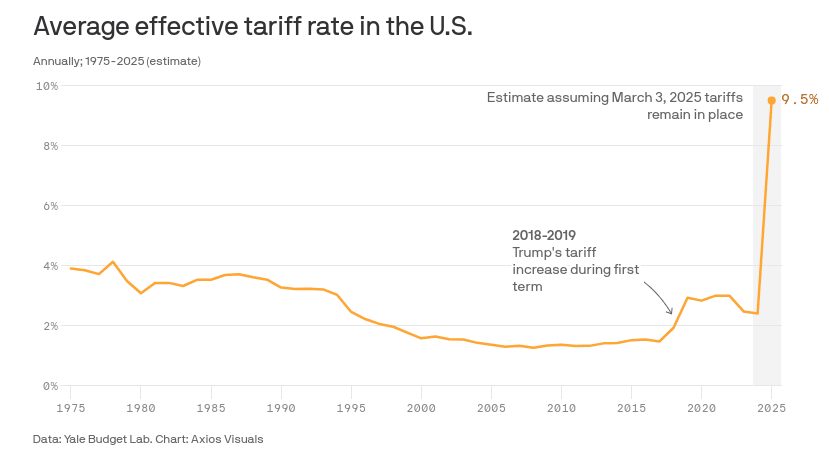
So What About Tariffs?
Update April 12 — Tariff Mini-PC Quote – US versus Poland versus Mexico – Apr12 — Comparing realtime quotes. Also latest CBP guidance and a list of US manufacturers as well. Buy American when you can we say! Support and maintenance is huge overlooked factor. Article link
Update March 5th — It took a month by tariffs announced on Canada, Mexico and China. This time around, the president is choosing across-the-board tariffs over targeted ones, invoking a legal authority with fewer constraints, and not giving time for companies to plead their case for special exceptions. It’s only been 2 days though and odds are pretty good Trump will announce some deal in his favor and mitigate them.

The line chart presents the average effective tariff rate in the U.S. from 1975 to 2025, highlighting stability until a spike during Trumps term in 2018-2019. With tariffs unchanged, a rise to 9.5% is expected by 2025, potentially impacting kiosks and digital signage industries. Data source: Yale Budget Lab.
Article on Impact of Tariffs on kiosks and digital signage. With the election comes new trade policies. One in particular is tariffs. If put in place, it will have ramifications across the kiosk and digital signage industries. Article on AVIXA
It’s early on for sure but good idea to lay out starting framework for cautions and also new opportunities.
Updates:
-
Seeking Alpha 11/25 — Trump’s tariffs could cost Americans $78B in annual spending power: NRF – The increased prices would be too high to be absorbed by U.S. retailers, resulting in prices that many consumers would be unwilling or unable to pay, the NRF report said.
- Cryptopolitan 11/25 — No-one wins in a trade war’ – China warns Trump against crashing the global economy. China has fired back at President Donald Trump’s latest threat to slap a 10% tariff on all Chinese imports.
- Speaking with lawyers specializing in business formation there is a big rush by Chinese companies to set up US offices.
- Many Chinese companies have already set up in Vietnam
- Nice post by Dave Haynes 11/26 on digital signage impact
——-
The kiosk industry has always had a complex relationship with Chinese component and kiosk pricing. We love to buy devices at the lowest cost, such as barcode scanners, touchscreens and displays. The kiosks selling for a third the price (before shipping) are not so loved. Made in China, it is easy to find.
This year, in order to learn and understand more, I began an Asia Pacific group on WhatsApp and began recruiting participants, primarily from Shenzen but from all over. The Grotto image is from Luoyang, where one of my members makes lockers, for example. I have 50 participants currently.
The recent election has raised potential outcomes that directly impact both Chinese suppliers and American manufacturers. Tariffs have long been a negotiating tool but have also been implemented and implemented. Importers pay that fee. See article on APnews explaining potential impact on China, US manufacturers utilizing China and Mexico (100% tariffs).
In February 2025, there is a strong possibility for additional tariffs, as high as 60% for Chinese goods. I have advised my APAC members to prepare and consider as the probability of some type of impact is relatively high. Maybe there is a two to three-month window for “buy now before the price goes up…”? FOMO is the acronym for selling tactics.
While the potential increase in tariffs may decrease competition for American-made kiosks, it’s important to note that those US-made kiosks also rely on main components from China, which means their costs are also likely to rise. However, this situation could also present new opportunities for the industry.
Generally, the cost of a kiosk consists of an enclosure, the computer, and the display. Usually assembled, which is another factor. Assemblies and parts are often treated differently.
Of note: BOE in China is the dominator regarding screens/glass.
Many Chinese companies have taken the unusual step of setting up mirror facilities in Vietnam, which faces different challenges.
My advice to my Chinese members? Sell as much as possible, as fast as possible, and then back off from the US market. Not surprisingly, my Chinese members had no idea of potential tariffs in play till I told them this week.
American kiosk producers would have an advantage, but higher profit is seductive.
It’s important to remember that this is relatively unknown and speculative. I’ve been an investor for 40 years so my first reference point is always the financial markets. I like to predict. As such, it’s crucial to approach the situation with caution but also a readiness to adapt to any changes that may occur.
Given the current situation and the potential for change, all industry stakeholders must prepare and carefully consider different scenarios. This proactive approach can help mitigate potential risks and ensure the industry’s resilience.
Pandemic — The Sequel? Good chance we might be headed towards parallel of pandemic when prices & costs increased “because of pandemic…). Tariffs present close approximation of those conditions. Walmart and Lowes have weighed in and support that idea. Walmart says, Walmart’s CFO, John David Rainey, said the retailer could have to raise prices on some items if President-elect Donald Trump’s proposed tariffs take effect. On an earnings call, Lowe’s CFO Brandon Sink said about 40% of the company’s cost of goods sold comes from outside of the U.S., including direct imports and merchandise from national brands. He said tariffs “certainly would add product costs,” but added “timing and details remain uncertain at this point.”
I’ll keep an eye out and will post comments and updates here.
Excuse me while I admire my unbelievable gains in digital currency and bitcoin markets over the last month…Not a big fan of Blackrock but the IBIT ETF has been stellar. It’s not hard to foresee less regulation of digital currency and wider monetization across American public in form of bitcoin ATMs and others. Fasten your seatbelt!
Comments:
How tariffs could be structured matters: Prior, the bulk of the products tariffs put on on were B to B products. By and large, tariffs on B to C products were not levied. Regarding the B to B product, if the tariff is raised to 60%, it is an actual 23% increase from the product currently tariffed at 30%.
Here is an example of cell phone carriers and iPhones to differentiate between B to B and B to C tariffs. When the cell carriers want to upgrade their store, the display that cost $1,000 before the first tariff now costs 1,300. At a 60% tariff, the carrier will pay $1,600 for the same display. The higher display cost is allocated against thousands of customers, so the impact on any one customer is pennies at most and not apparent to them. Restated, the cost impact to a given consumer is negligible.
Compare that to putting a 60% tariff on a new iPhone the consumer purchases from the carrier store. If the sell price of a $1,000 iPhone goes to $1,600, the consumer is painfully aware, and all hell would break loose on social media.


